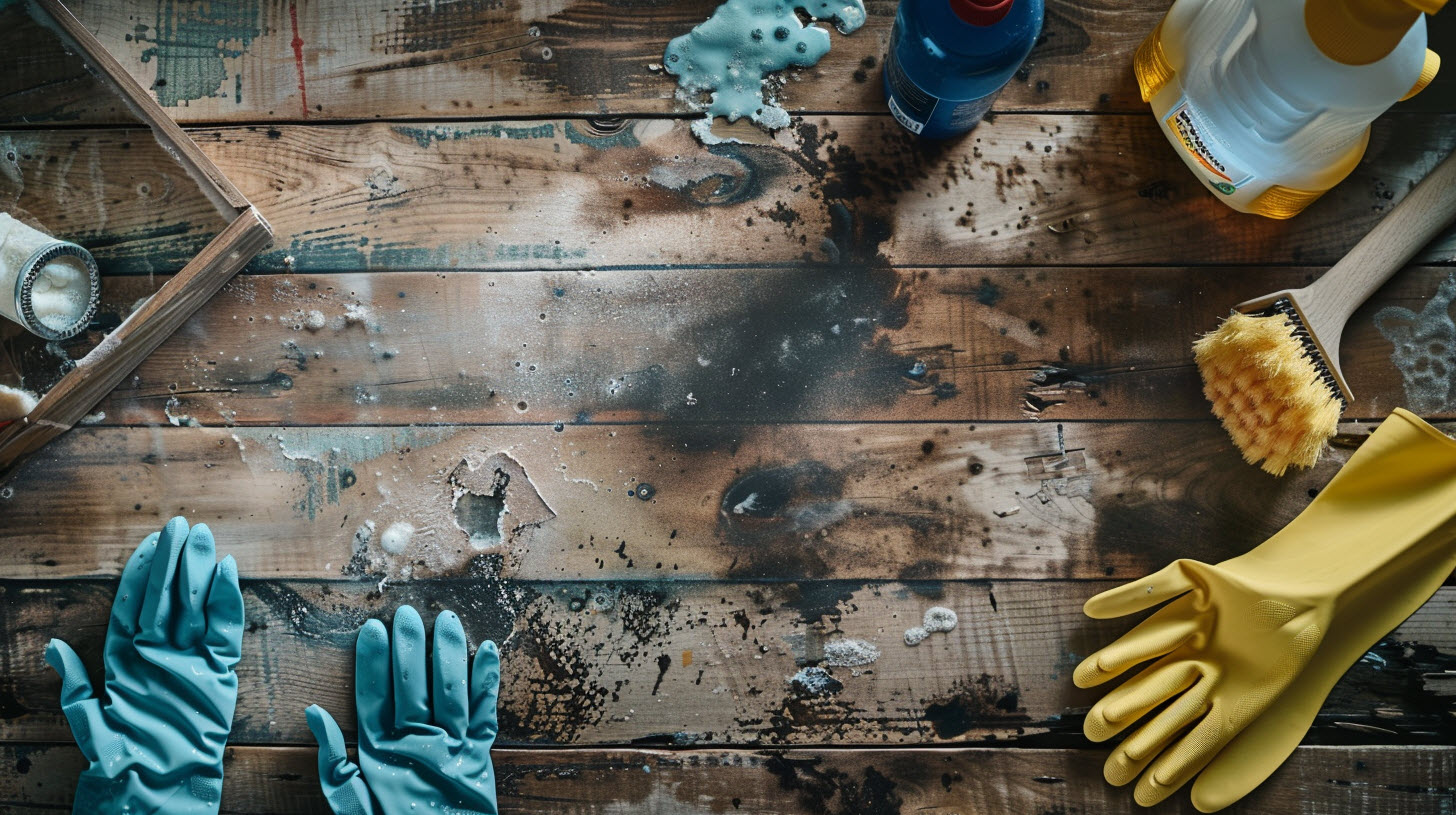When dealing with mold on wood, the first step is protection. Gear up with gloves, goggles, and a mask to safeguard yourself. But what comes next? Well, understanding the type of mold you’re facing can dictate the best removal method. Stay tuned to uncover the essential steps to effectively eliminate mold from wood surfaces and establish a mold-free environment for the long run.
Identifying the Mold Problem
To effectively address mold on wood, start by visually inspecting the surface for any signs of discoloration or musty odors. Mold inspection is essential in identifying the extent of the issue. Look for any visible mold growth, which may appear as black, green, or white spots on the wood. Additionally, pay attention to any areas that feel damp or have a musty smell, as these could indicate hidden mold growth within the wood.
If you’re uncertain about the presence of mold or the type of mold present, consider mold testing. This can involve taking samples from the affected wood and sending them to a laboratory for analysis. Mold testing can help determine the specific type of mold present and guide you in choosing the most effective removal method.
Safety Precautions Before Cleaning
Make sure you have the necessary protective gear before starting the cleaning process to safely remove mold from wood. When dealing with mold, your safety should be a top priority. Here are some essential safety precautions to keep in mind:
- Protective gear: Wear gloves, safety goggles, and a mask to prevent direct contact with mold spores and the cleaning solution.
- Proper ventilation: Maintain good airflow in the area by opening windows and using fans to avoid inhaling mold spores.
- Avoid skin contact: Mold can cause skin irritation, so it’s important to cover exposed skin with appropriate clothing.
- Use a mold cleaner: Choose a cleaning solution specifically designed to remove mold from wood surfaces effectively.
- Dispose of contaminated materials: Safely discard any materials like rags or brushes used in the cleaning process to prevent further mold spread.
Cleaning Mold From Wood Surfaces
When cleaning mold from wood surfaces, make certain that you have the necessary protective gear and a suitable cleaning solution. Wood restoration techniques can be effective in removing mold from wood surfaces without causing damage. Before starting the cleaning process, guarantee good ventilation in the area to prevent the spread of mold spores.
For chemical-free mold removal, you can create a cleaning solution using ingredients like vinegar, baking soda, or hydrogen peroxide. These natural remedies are gentle on wood surfaces while still being effective at killing mold. Remember to test the solution on a small, inconspicuous area of the wood first to ensure it doesn’t cause any damage.
To clean mold from wood effectively, use a scrub brush or sponge to apply the cleaning solution. Scrub the affected areas gently, making sure to cover the mold completely. After cleaning, allow the wood to dry thoroughly. If the mold persists, you may need to repeat the cleaning process or consider seeking professional help for stubborn mold infestations.
Using Natural Remedies for Mold Removal
Start by mixing a solution using natural ingredients such as vinegar, baking soda, or hydrogen peroxide to effectively remove mold from wood surfaces. These natural remedies aren’t only eco-friendly but also safe for you and your family. Here are some items you can use for mold removal:
- Vinegar Solution: Vinegar is a potent natural cleaner that can help kill mold spores and prevent regrowth.
- Baking Soda Paste: Baking soda is abrasive and can scrub away mold stains while deodorizing the area.
- Hydrogen Peroxide Spray: Hydrogen peroxide is a powerful antifungal agent that can effectively kill mold on wood surfaces.
- Tea Tree Oil Spray: Tea tree oil has natural antifungal properties that can inhibit mold growth.
- Lemon Juice Solution: Lemon juice not only helps to remove mold but also leaves behind a fresh citrus scent.
Using these natural remedies can help you tackle mold on wood surfaces effectively and safely.
Preventing Mold Growth on Wood
To prevent mold growth on wood, ensuring proper ventilation and maintaining low humidity levels is vital. Preventing moisture buildup is key to mold prevention. Proper ventilation helps to keep the air circulating, reducing the chances of moisture accumulating on the wood surface. Additionally, maintaining low humidity levels below 60% can greatly hinder mold growth.
Regular inspections are essential in preventing mold on wood. By regularly checking for any signs of water leaks, condensation, or dampness, you can catch potential issues early on and address them promptly. Inspect areas prone to moisture, such as basements, attics, and bathrooms, to ensure that any water-related problems are identified and resolved quickly.
Incorporating these preventive measures into your routine maintenance can help safeguard your wood surfaces from mold growth. By proactively managing moisture levels, ensuring proper ventilation, and conducting regular inspections, you can effectively prevent mold from taking hold on wood surfaces.
Conclusion
To sum up, removing mold from wood requires proper identification, safety precautions, and effective cleaning methods. By using mold-specific cleaners or natural remedies like vinegar or hydrogen peroxide, you can eliminate mold from wood surfaces.
Regular maintenance and monitoring for moisture can help prevent future mold growth. Stay safe, be proactive, and keep your wooden surfaces mold-free.
